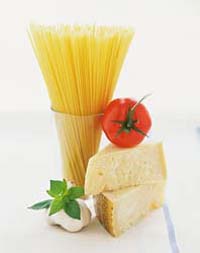Pasta makes Italians protest
The rising food costs – especially on precious pasta - made Italians organize nationwide protests Thursday.

The price of basic commodities are being driven up by middlemen, while farmers and producers earnings remain flat, activists said at protests in Rome, Milan and Palermo.
In the case of pasta, Italians will soon be paying up to 20 percent more for their daily serving, be it fettuccine, linguine or spaghetti. Thursday's one-day strike was not against eating it, but against buying it.
"Prices increase by five times between production and consumption," Toni De Amicis, a leader of Italian farm lobby Coldiretti, said during the protest in Rome. "The right recipe is to reduce the gap between production and consumption."
The increase in the price of pasta is being driven by rising wheat prices worldwide, economists and producers say. The demand for wheat is the result of several trends, chiefly an increasing demand for biofuels, which can be made from wheat, and improved diets in emerging countries where putting more meat on the table is raising the demand for feed for livestock, said Francesco Bertolini, an economist at Milan's Bocconi University.
As a result, wheat stocks worldwide are being depleted to their lowest levels in decades and grain prices are soaring.
Italy produces only about half of the high-protein durum wheat used to make high-quality pasta and bread; the rest is imported from overseas markets including the United States, Canada and Ukraine.
Still, even with the projected increases, "There is no dish that costs less," said Furio Bragagnolo, the vice president of the Italian pasta manufacturers association. "Whoever decides to strike against pasta will spend more on whatever they buy instead. A plate of pasta probably costs less than an apple."
On the Bologna market, for example, the cost of a kilogram (2.2 pounds) of durum flour has risen in just the last two months from EUR0.26 ($0.36) to EUR0.45 ($0.62), Bragagnolo said. Durum flour constitutes 70 percent of the cost of producing pasta.
In the Italian supermarket, that will translate by the end of the year into an increase of EUR0.12-EUR0.14 (US$0.16-US$0.19) on a half-kilo (1.1-pound) package, which now typically runs from EUR0.60 to EUR0.90 (US$0.83 to US$1.25), Bragagnolo said.
Even at higher prices, Bragagnolo said the price of a portion of pasta - 100 grams, excluding sauce, of course - will be about EUR0.17 to EUR0.18 (US$0.23-US$0.24).
Those who are mostly likely to be concerned, producers say, are those on a fixed income, such as 70-year-old Francesca Sanfelice. "The price increase will affect how I shop. Already, I'm buying less bread, which is helping me lose weight," Sanfelice laughed.
Subscribe to Pravda.Ru Telegram channel, Facebook, RSS!


